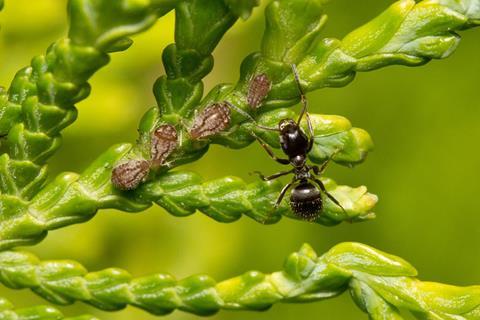Ant queens typically found new colonies on their own, and at the early stages are highly vulnerable to their brood being wiped out by disease. Researchers at Oxford’s Department of Biology theorised that killing off sick larvae before they became infectious could be a strategy used by queens to combat this threat.

READ MORE: Ants recognize infected wounds and treat them with antibioitcs
READ MORE: Sneaky pathogenic fungi hide from ants by dialling down their natural signals
To test this, the researchers presented founding queens of the black garden ant (Lasius niger) with larvae that had been infected with a fungal pathogen Metarhizium for 24 hours. At this point, the infection was lethal, but not yet transmissible. The queens cannibalised 92% of the infected larvae – leaving no remains – but only 6% of control larvae which had not been infected.
Lead researcher Dr Chris Pull (Department of Biology, University of Oxford) said: ‘Once the queens find a sick larva in the brood pile they get to work immediately and spend a several hours chewing them up until they’re all consumed’. Despite the potential risk of infection, all queens survived after eating the infected larvae.
The researchers suggest the queens may protect themselves by swallowing an acidic, antimicrobial venom which they produce from a special gland at the end of their abdomen. Indeed, some of the queens were seen massaging the opening of this gland during and after cannibalism.
Queens that cannibalise larvae lay more eggs
The queens who cannibalised their infected larvae went on to lay 55% more eggs than non-cannibalising control queens, indicating that the nutrients from the ingested offspring were recycled for reproduction.
Co-author Flynn Bizzell (Department of Biology, University of Oxford) said: ‘Ant queens start their colonies alone and essentially starve themselves to raise their first workers. The queens who produce the most workers have the best chances of survival, so being able to eat and recycle infected larvae back into brood production means valuable resources are not wasted”.
When the queens were presented with diseased larvae which had progressed to the infectious stage, they did not attempt to eat these. Instead, the queens sprayed the infectious larvae with their antimicrobial venom as though to attempt to control the infection. Even so, around most (80%) of the queens still contracted the disease and subsequently died. Acting early, before larvae become infectious is key.
Hygienic cannibalism
Curiously, this ‘hygienic cannibalism’ has only been observed in queens, and never among mature worker ants. This may be because, unlike queens (who seal themselves into the nest), worker ants can dispose of infected larvae by carrying them out of the nest.
Dr Pull added: ‘Our results provide compelling evidence that cannibalism solves the problem of disease containment and corpse disposal in the confined space of founding queens underground bunker, whilst also ensuring valuable nutrients are not wasted - and that this improves their chances of successful colony foundation.’







No comments yet